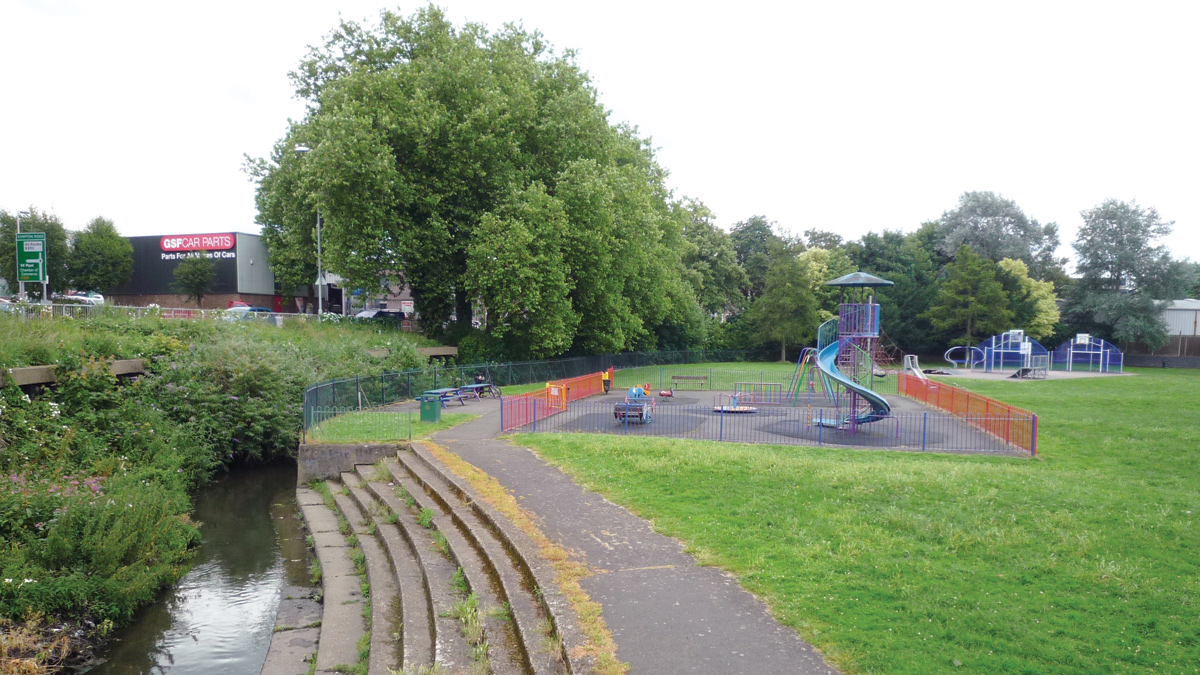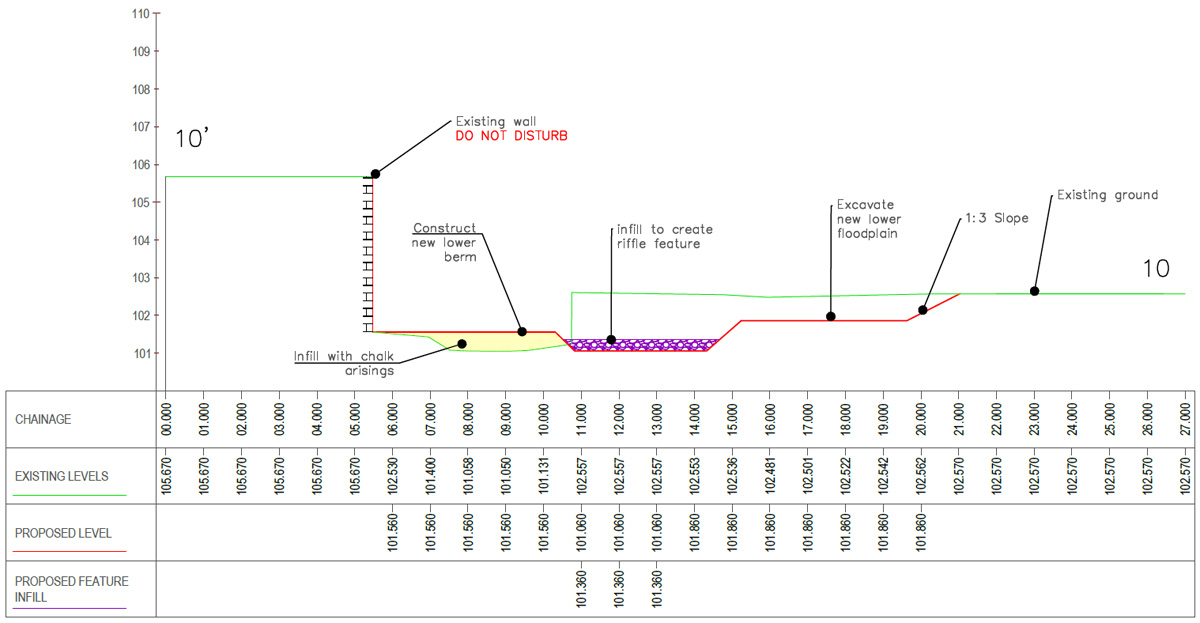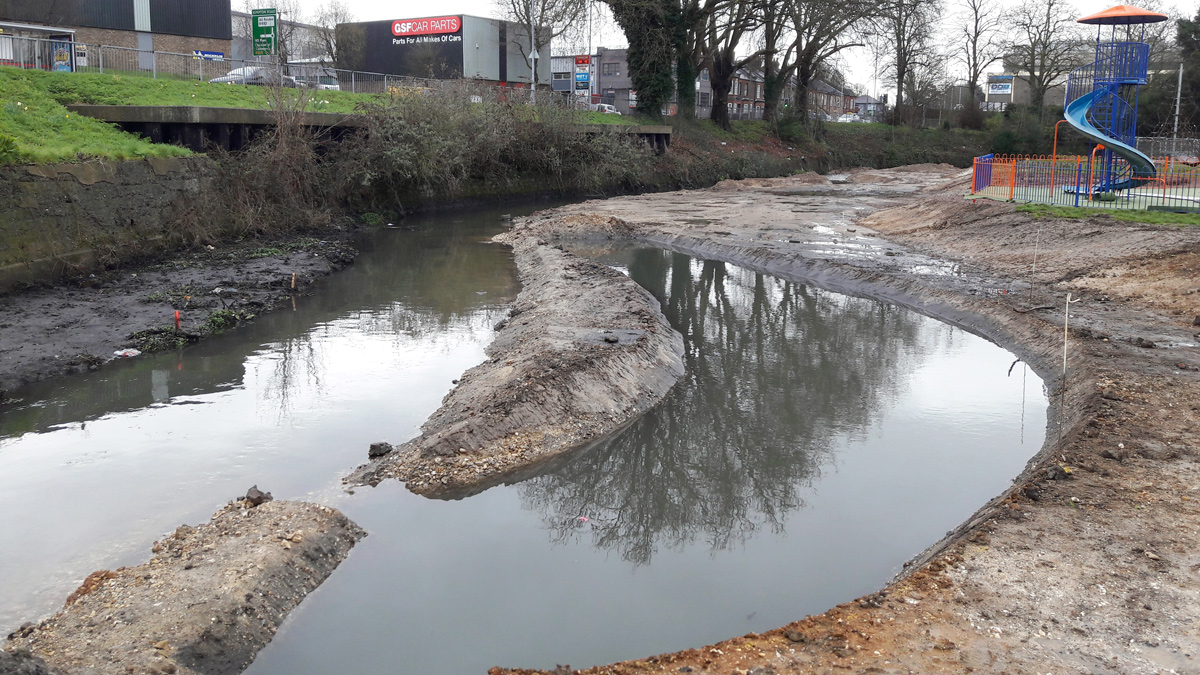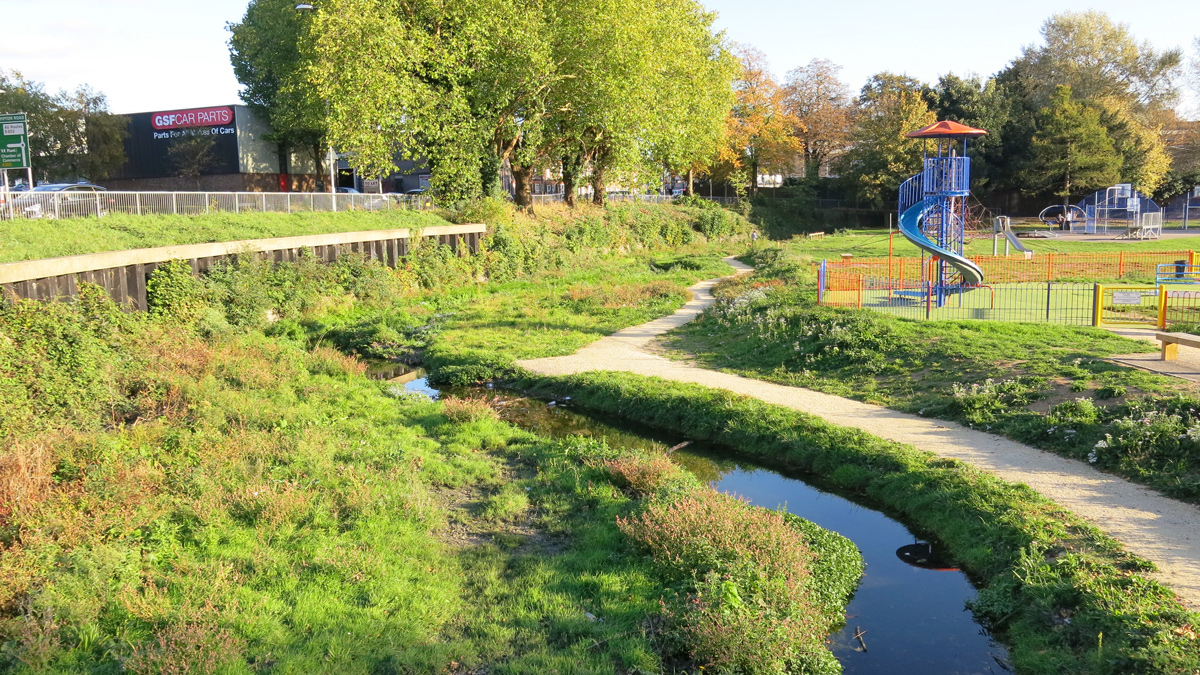Manor Road Park River Restoration Project (2019)

Figure 1: Manor Road Park before the river restoration project - February 2018. The river is confined to a concrete channel to the side of the park behind a concrete wall and railings - Courtesy of Affinity Water
Affinity Water (AW) is the largest water-only supply company in the UK, providing on average 900 million litres of water each day to a population of more than 3.6 million people in parts of Bedfordshire, Berkshire, Buckinghamshire, Essex, Hertfordshire, Surrey, the London Boroughs of Harrow and Hillingdon and parts of the London Boroughs of Barnet, Brent, Ealing and Enfield. We also supply water to the Tendring peninsula in Essex and the Folkestone and Dover areas of Kent. Along with supplying high quality drinking water, AW have embarked on an ambitious programme to improve the health of rivers within our supply area through a holistic approach to environmental sustainability. Through a combination of Catchment Management, abstraction reduction and river restoration works, AW aim to sustain healthy groundwater levels, improve water quality, improve channel morphology, and flows in globally rare chalk streams.
Background
The Environment Agency (EA) placed targets (through the Water Industry National Environment Programme) for Affinity Water to contribute to improve the EU Water Framework Directive (WFD) classification of the Rivers Lea, Mimram, Ver, Beane, Gade and Misbourne, that run through the home counties, to support Good Ecological Status/Potential (GES/P) by 2027.
The Manor Road Park River Improvement Project is one of several projects that have been scoped on the Upper River Lea from Luton to Luton Hoo Lakes) in collaboration with the landowner Luton Borough Council (LBC), the Luton Lea River Catchment Partnership and the EA. These projects are also part of the wider Affinity Water and EA Revitalising Chalk Rivers Partnership, which aims to help restore and improve the habitat of chalk streams along the Rivers Beane, Gade, Lea, Mimram, Misbourne and Ver within the Lea and Colne catchments.
Project scope
The River Lea is a Chalk Stream that flows through the urban centre of Luton. The river has been heavily modified, straightened and culverted over many years of development. This has disconnected the river from groundwater, its natural flood plain and from geomorphological processes. A wide variety of other pressures, such as surface run-off, pollution events, litter and mis-connections have also impacted on the river’s health.
The river at Manor Road Park was confined to the edge of the park in a concrete channel behind metal railings (Figure 1 – Top), totally disconnected from the park and the local community. The channel was heavily shaded by trees with very little in-channel vegetation. The aims of the project:
- To naturalise 140m of river bank and channel bed.
- To improve biodiversity within the river corridor.
- To help the river meet ‘good ecological potential’ under the WFD by 2027.
- To make the river more resilient to low-flows and future climatic conditions.
- To set up a monitoring network to capture the hydrological, morphological and ecological responses to the river restoration works.
A collaborative approach incorporating Luton Borough Council, the Environment Agency and the designer (AECOM) hosted by Affinity Water ensured each stakeholder contributed ideas and provided valuable insights into the scope and design of the restoration project. The early involvement of all stakeholders led to the successful delivery of consents and permits as well as the delivery of the project.
Design objectives
The restoration works were designed to naturalise the river banks and reconnect the river to the surrounding environment, to create a two-stage channel, reinstate morphological river processes and to increase biodiversity.
To naturalise the river, Affinity Water removed and disposed of 250m3 of concrete. In breaking the river free from the concrete channel and allowing it to flow along its natural flood plain, the river will be reconnected to the surrounding groundwater and reestablish the hyporheic zone. The flow dynamics and behaviour in this zone is important for surface water and groundwater interactions and a good habitat for macroinvertebrates and spawning fish.
A two-stage profile of the river banks will ensure the river is sustainable, future-proofed and resilient to future climate change impacts (see Figure 2 below).

Figure 2. A cross-section of the new two-stage river channel at Manor Road Park, shown by the red line. The green line illustrates the previous existing ground level and river channel. The two-stage channel allows the river to come out of bank in times of peak flow and to self-adjust within the main channel at times of low flow – Courtesy of AECOM (2018)
The new bank profile will increase the flood capacity of the area by 1,550m3, reducing flooding pressures downstream and maintain flows during low rainfall events, prolonged dry periods and drought conditions. The vegetated reprofiled banks and berms will also provide a refuge for the macroinvertebrates and fish in times of high flows and help prevent them being washed downstream.
The new meandering river channel is designed to kick start natural river processes. The five berms were constructed from 130m3 of soil recovered from the new flood plain, a further 1855m3 of soil was removed from site, as this could not be repurposed on the flood plain. Six riffles were constructed using 70m3 of clean, washed gravel, a graded mix of 50% coarse gravel (50-100mm) and 50% medium gravel (20-50mm) and pools of different depths were formed below each riffle. These in-channel features create different river flow dynamics and multiple habitats for plants, insects and fish increasing biodiversity within the river corridor and supporting the River Lea in meeting good ecological potential under the EU WFD.
Sustainable urban drainage measures were designed under two surface water outfall pipes. Coir rolls were used to dissipate and slow the intensity of flow from the outfalls, preventing erosion of the berms whilst also filtering fine particulate matter out and improving water quality.
A riverside path was also commissioned with viewing points to encourage the local community to interact with the river. The path sub-base consists of course gravels (60mm) with a surface covering of 90% porous crushed concrete and 10% local soil. Three natural benches were cut into the flood plain bank for visitors to sit on reducing the risk of vandalism and maintenance costs.
Project timeline
- Outline design: April 2016 to July 2016
- Detailed design: May 2017 to July 2017
- Construction: February 2018 to May 2018
Technical challenges
- Protracted channels of communications through the various departments at the local Council led to misunderstandings and a delay with the access agreement for permission to access the work site, this caused a three-week delay to the start of the project. We have streamlined the lines of communication within the Council and will build in extra time for this process to ensure future projects start on time.
- The relocation of the playground was treated as a separate contract to the river design and construction contract. This led to a slight boundary issue between the flood plain bank top and the relocated fencing of the children’s playground. The issue was resolved on site between the designer and contractors, future projects will be sense checked if there are sub-projects within a project.
- The design drawings omitted a cross section at the point where the new channel connected with the old channel at the downstream section. This delayed the works slightly while revised design plans were drawn up following a site visit with the designer and contractor.
- The crushed concrete delivered to site for the path surface was contaminated with broken tiles and bits of plastic, this caused a delay to the project as new material needed to be reorder.
On site challenges
- A period of intense rainfall over several days caused flooding of the site and a breach into the new river channel. The site was unsafe for work causing a delay to the project by a week (Figure 3 below).
- Following a high river flow event, the newly created berms became populated by a wide variety of tomato plants. A volunteer day was required to pull up all the tomato plants and remove them from site. There are no sewage treatment plants upstream of Manor Road Park therefore this suggests there is a mis-connection issue within the Luton surface water catchment area.
- The extended dry period of weather throughout the summer of 2018 prevented the reinstatement and establishment of the amenity grass area under the site compound and track matting. Two of the four alder trees planted died, these had been planted too late in the season and could not survive the long period of hot, dry weather. The full reinstatement of this area had to be delayed till the following spring of 2019.
- The new river channel has been designed for low cost and time maintenance for the local authority. A post construction maintenance plan was provided for the landowner to follow. Unfortunately, it appears the maintenance plan for the park was not up dated and the flood plain banks were strimmed in the spring of 2019.

Figure 3: After an intense period of precipitation over several days the river breached the new excavated channel. The work site also flooded and work on site stopped for safety and delayed by a week – April 2018 – Courtesy of Affinity Water
Benefits
Where the park was once a monoculture of amenity grass, the new berms and wetland areas have been planted with a mixture of seed and plug plants of typical chalk stream species, such as Meadow Buttercup, Common Sorrel and Greater Bird’s Foot Trefoil on the meadow/wetland areas and aquatic species Water For-get-me-not, Water Mint and Fools Watercress along the river banks.
The variety and complex structure of the macrophyte flora now created within the new river channel, berms and wetland areas will encourage a variety of insects both terrestrial and aquatic to feed and populate a once sterile park land landscape (Figure 4 below).
The new wetland area has provided an extra 1,550m3 of flood capacity within the floodplain of the park. This will help to slow the flow preventing flooding issues further downstream. The wetland area will also retain and give time for flood water to be absorbed and filtered through to the groundwater.

Figure 4: Manor Road Park after construction of river improvement works. The river is now reconnected to the groundwater and flood plain in a new meandering channel with riffles and pools creating multiple habitats for macrophytes, macroinvertebrates and fish – October 2018 – Courtesy of Affinity Water
Opportunities
Although the project was a regulatory requirement of Affinity Water through the EA National Environment Programme, there has been a ripple of additional and unexpected benefits and opportunities that have arisen due to the river restoration works.
- There is a growing sense that people are becoming more connected and interested in the river. The park is now being used as a recreational and educational resource by local community groups and schools.
- The Luton Lea River Catchment Partnership hosted by Groundworks now uses Manor Park as a water quality test site for the Junior River Warden Scheme which we funded.
- A Cranfield University MSc student will be undertaking a natural capital assessment of the river restoration works for their thesis dissertation.
- The relocated children’s playground has new play equipment that provides access for children with disabilities, there is a ground level roundabout for wheel chairs and push chairs, as well as a swing that is accessible to children that cannot sit up on a normal swing.
- The river now provides an aesthetically pleasing, calm space to connect with nature in an urban environment, improving people’s mental health and wellbeing.
This project will be used as a case study to influence future stakeholder discussions and buy-in for further restoration works for Affinity Water’s AMP6 and AMP7 river restoration programme. It provides evidence of workmanship and highlights our commitment to protecting the globally rare chalk streams and the environment, ensuring any impacts of our activities are minimised.
The project also highlights other external factors that are impacting the river’s health, such as misconnections, surface run-off, water quality and litter. It has also raised awareness of water scarcity in South East England, educating customers in being water wise, linking household water use to depleting water resources in the local environment and river.
Manor Road Park River Restoration Project: Supply chain
- Designer: AECOM
- Construction contractor: Salix River and Wetland Services Ltd
- Ground penetrating radar: University of Hull
- Tree works: Maydencroft Ltd
- Playground contractor: Kompan Ltd
Conclusion
This project was one of the first AMP6 river restoration projects to be implemented by Affinity Water and was a huge learning curve for us. We learnt how important it is to schedule in time for stakeholder engagement. The importance of ensuring any sub-projects tie in to the overall project design. To build strong transparent lines of communications between ourselves, the designer and construction contractor and our regulators and stakeholders.
The time required for stakeholder engagement and public consultation was underestimated during the initial discussions and design of the proposal. However, this time was well spent as the successful delivery of the river restoration project stems from this early stakeholder engagement and involvement. From the first river walk over, to the discussions and contributions at design stage, valuable information was shared, informed decisions made, and a shared vision of the expectations agreed.
All stakeholders can be rightly proud of the transformation of the River Lea through Manor Road Park, which provides an enhanced recreational space for the local community, multiple habitats for a diversity of plants, insects and fish and a chalk stream resilient to future climatic conditions.
The monitoring network set up before the restoration works will continue to be monitored until at least 2025. The extended monitoring will capture evidence of the success, benefit, response of the hydrology, morphology and ecology following the river restoration work. There is an ongoing challenge of pollution pressures which will need to be addressed by multiple stakeholders such as, Luton Borough Council, Environment Agency, Highways Agency and Thames Water. The evidence collected by our monitoring will help inform these further discussions.




